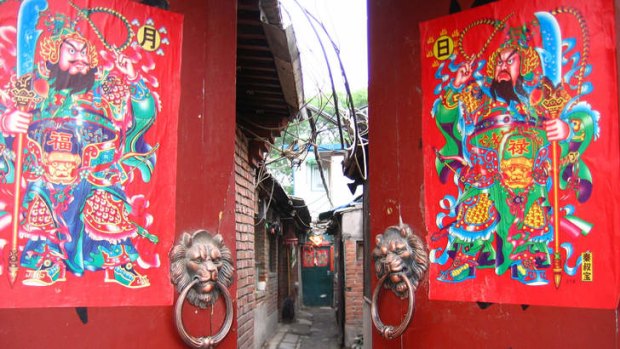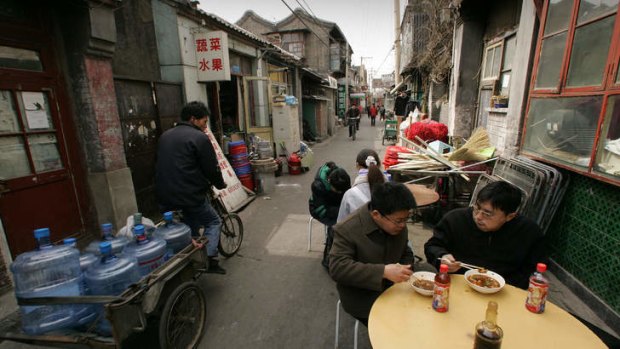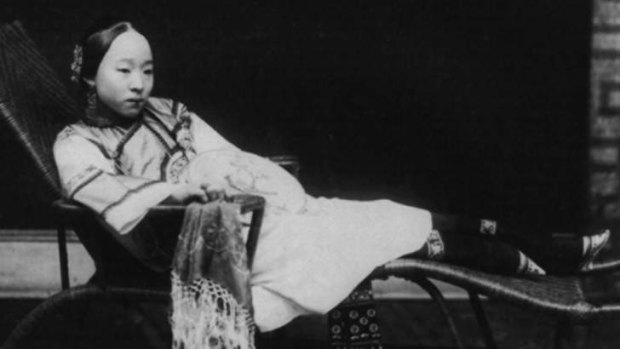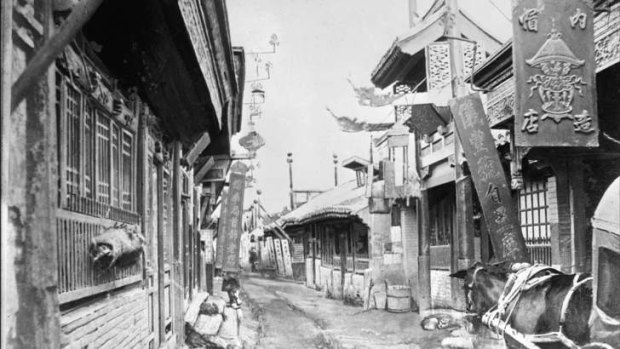
China trail: the gate at a Hutong courtyard house.Credit: Alamy
Gabrielle Jaffe follows the trail of "Golden Lilly" the courtesan reputed to have saved China.
'Welcome to my humble brothel," jokes Simon Gjeroe, our 1.8-metre-plus guide. Kowtowing to fit through the doorway, he ushers us into a two-storey building that was once one of Beijing's bordellos.
Today we are touring Bada Hutong, a 1.2 square kilometre area that is just south of Tiananmen Square and was the Chinese capital's red-light district from the time of the Ming dynasty (1368-1644) until the communists took over in 1949.

The Hutong of Dazhashan, Beijing.Credit: AFP
In its heyday, this warren of lanes housed more than 300 brothels and 700 opium dens.
There were whorehouses to cater for every taste and budget.
In the fanciest, fresh-faced girls sang songs, poured tea and entertained men in much the way geishas do in Japan. These women's bodies were not bought outright; instead, would-be suitors wooed them with gifts over time.

An early 20th-century courtesan.Credit: Beijing Postcards
For those leaving such places unsated, however, there were also spots where heavily perfumed and thickly made-up street-walkers openly sold sex.
After the Second Opium War (1856-60), a new breed of customer began frequenting Bada: foreigners from the nearby Legation Quarter.
Business boomed: by the turn of the century, Bada brimmed nightly with rows of red lanterns, screeching rickshaws and the heady scent of opium.

Historic Hutong.Credit: Beijing Postcards
At first it's hard to picture this scene as we stand in this dilapidated house, with half-exposed brick walls and broken banisters. Then Simon asks us to look up from the interior courtyard and imagine the girls in their white silks, coyly staring down at us from the second-floor gallery.
Simon and his fellow Dane, Lars Thom, are the perfect guides for this tour.
These enthusiastic historians and founders of the popular Beijing Postcards shop have lived in China for more than a decade and spent a lot of time chasing down stories and pictures of old Beijing in local archives and flea markets.
At our second stop, they point out a stone carving above a doorway, which in Mandarin reads "collected treasure" - a euphemism, apparently, for the high-class prostitutes who once lived inside. Today this duo aren't just showing us around former houses of ill repute; they are helping us follow in the tiny bound footsteps of one of the area's most famous residents: Sai Jinhua, the "Golden Lily" courtesan, whose roller-coaster life saw her earn a reputation as the saviour of the Chinese nation.
Obscured under the thick veils of myth, facts about Sai aren't easily ascertained.
Some say she was born in 1874, others claim earlier. Aged about 14, she married Hong Jun, a high-ranking official more than 30 years her senior, whom she met in the floating brothels of Suzhou.
Sent as a special emissary to Europe from 1887 to 1890, Hong took Sai along with him, where she learnt German and mixed with the highest levels of society. After Hong's death, Sai escaped to Beijing and began working once again in a brothel.
To quell the Boxer Rebellion, in 1900 an international force under the command of a walrus-moustached German general, Alfred von Waldersee, took over Beijing.
One night, as German officers burst into one of Bada's brothels, the diminutive Sai began scolding them in their own language.
Impressed with her German, they employed her as a translator. On meeting General Waldersee, she is said to have rekindled an affair from her time in Germany.
It's claimed that Sai used her influence over the general to secure clemency for some of her countrymen, who would otherwise have been executed, and to help broker a favourable peace settlement between the Chinese government and the alliance of foreign powers.
During their reunion, the couple reportedly stayed in Empress Cixi's palace and, when it caught fire one night, were seen running out naked. At least, that's how the story goes.
In reality, this tale is quite unlikely, not least because Sai would not have been able to sneak off to meet Waldersee behind her husband's back while she was in Germany - with her bound feet she couldn't sneak off anywhere.
Whatever the truth, Sai quickly became a cherished symbol, an ordinary person who stood up to the foreign powers and succeeded where the imperial government had failed.
Sai used her new-found celebrity to procure more business: in the year following her rumoured coup, she is said to have earned two kilograms of silver daily.
To visit the brothel she built in Bada during this period, we file down an alley so narrow that a cat is able to jump between the rooftops either side of it.
Inside, the past grandeur of the building is evident in its size and in its three-metre-high, Western-style stone arches.
However, today the scene is anything but glamorous. Situated in what is now one of the poorest parts of Beijing, Sai's former brothel has become slum housing, with dozens of residents crammed into the one-time pleasure rooms.
The area's fall from grace mirrors Sai's own destiny.
In 1903 she was jailed, then expelled from Beijing, after being accused of mistreating one of her prostitutes who committed suicide.
After a brief spell of happiness with another husband, by the 1930s she was living in Beijing in near destitution.
Though her life lost lustre towards its end, her legend didn't. As we stroll towards Capital M, an art deco restaurant where we will conclude the tour with a cocktail, our Danish guides recount the numerous times Sai's story has been portrayed in Chinese literature and cinema.
Sipping our drinks, I reflect on how this has been a unique chance to trace the myth of an unlikely heroine, so celebrated in China but little known in the West.
Telegraph, London
The Sai Jinhua walk is available through Bespoke Beijing (www.bespoke-beijing.com) as a private tour for up to 10 people for 3500RMB. The travel company also runs walks as public tours, priced at 250RMB per person on select occasions throughout the year.
Sign up for the Traveller Deals newsletter
Get exclusive travel deals delivered straight to your inbox. Sign up now.